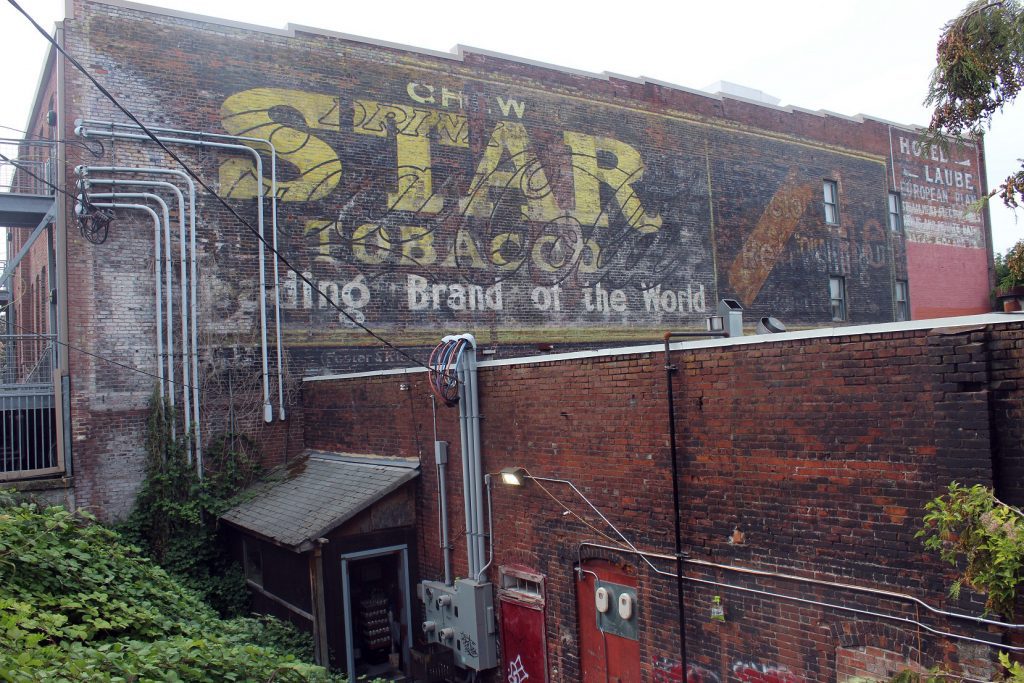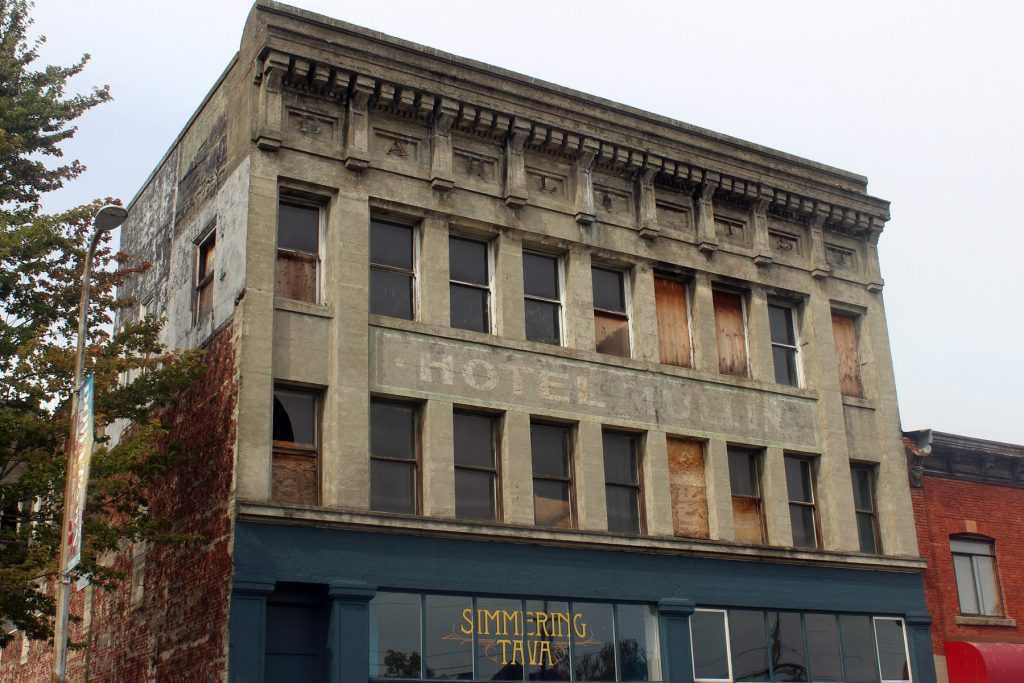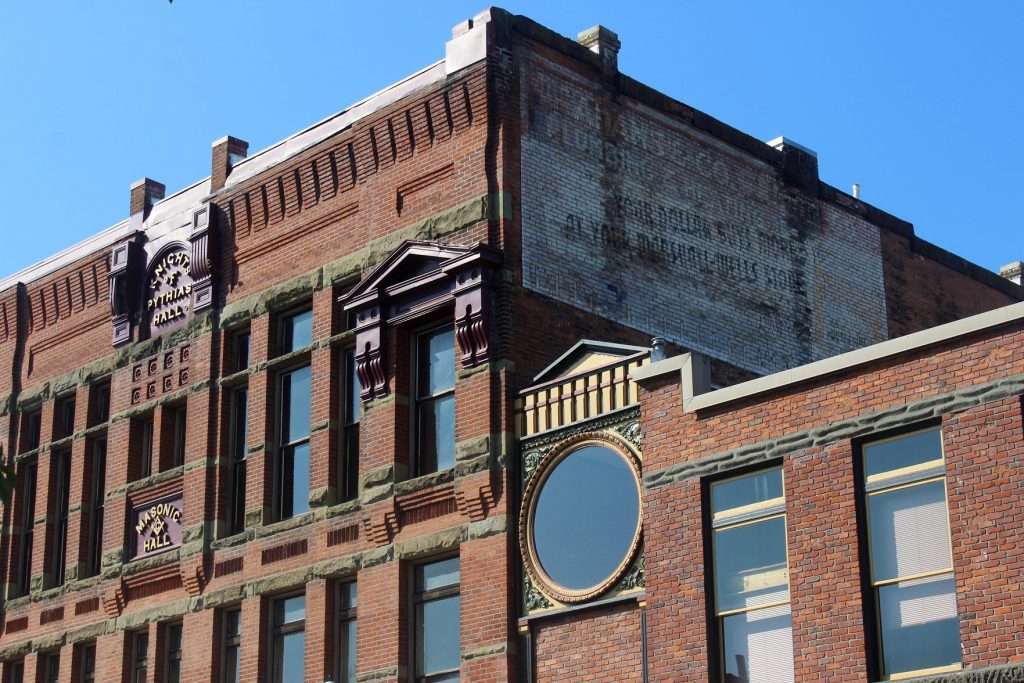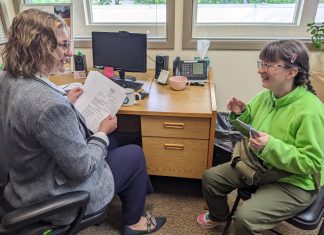Walking through downtown Bellingham and Fairhaven, visitors can catch glimpses of the past. “Old Town” Bellingham is the haunt of numerous ghost signs: faded signage and advertisements that are withstanding the test of time.
In the late-nineteenth through mid-twentieth centuries, business owners and advertisers painted logos on brick buildings and barns throughout the country. Many used lead paints, which have survived the elements long after their regulation.
Ghost signs have a mixed reception. Cities and property owners may paint over them as a nuisance or keep them for nostalgic appeal, even repainting them. Photographers and hobbyists gather online to document ghost signs before they disappear forever.
Bellingham’s ghost signs harken back to the city’s turn-of-the-century boom in logging, fishing, mining, and railroading. Exorcising ghost signs’ history reveals the tales of edifices that outlived them.
Downtown Signs
Some of Bellingham’s most prominent downtown ghost signs reflect its twentieth-century reputation as a “hotel city.” The block now hosting Laube Apartments (1226 N. State St.) and Windsor Building (1218 N. State St.) bears the names of two such luxury lodgings: Hotel Laube and Windsor Hotel. Both started in 1903 and continued as hotels into the 1970s.

Although the advertisement of Hotel Laube’s “European Plan” facilities has faded, passersby can still read ads for Star Tobacco (“Leading Brand of the World”) and Coca-Cola (featuring 1904 slogan “Delicious and Refreshing”).
The Dahlquist Building (1311 N. State St.) still bears signs for Hotel Mullin and Antler Apartments. Thomas B. Alquist built the reinforced concrete structure for Bellingham Bay Grocery Company in 1888, selling automobiles in the basement as Samuel Mullin ran the residential hotel. The upper floor became Hotel Mullin in 1913, Antler’s Hotel in 1925, Moore’s Apartment in 1946, and Antler Apartments from 1946 to 1963. A 1976 fire has left the upper floor disused to this day.

Other property owners have preserved signs downtown. At the Commercial District’s outskirts, Lottie Roth Block (1100-1106 W. Holly St.) preserves a Coca-Cola advertisement repainted to read “Welcome to Old Town.” Charles I. Roth commissioned this Chuckanut sandstone building from Elmer H. Fisher in 1888. The block initially housed storefronts and has housed apartments since 1918, as the brick walls’ faded signage attests.
Lottie Roth Block and D’Anna’s Café Italiano (1319 N. State St.) near Dahlquist Building both display “5 Cent Cigar” ads by the Henry George Cigar Company.
One downtown ghost sign’s entrepreneurial spirit lives on through a billboard obscuring it. The former YMCA building (311 E. Holly St.) hosted the organization advertised on its sign before moving to its present location in 1942. Afterward, the Independent Order of Odd Fellows occupied the building into the 1970s.
Fairhaven Signs
Fairhaven’s few historic buildings still have their pasts emblazoned on them. The Knights of Pythias Building (1208-1210 11th St.) displays two signs for “Adams & Co Plumbing & Hardware” — a tenant from 1907 to 1912, lasting until 1972 as Groom’s Hardware. Other signs advertise United Groceries and Marshall-Wells Store. The Order of Knights of Pythias occupied this Chuckanut sandstone building from 1891 into the 1920s, moving meetings to the Leopold Hotel. They shared space with organizations such as the Odd Fellows, Masons, and Rathbone Sisters.

Two of Fairhaven’s original pharmacy locations bear faded signs. Formerly Mason Block, Sycamore Square (1303 12th St.) has a now-illegible sign for David Alverson’s pharmacy. Alverson purchased the original pharmacy from D.P. Mason Drug Co. in 1891, moving it to Mason Block in 1895. The pharmacy kept changing hands and locations until George Finnegan purchased a new concrete building (1115 Harris Ave.) in 1929. The façade displays the outline of Fairhaven Pharmacy’s original lettering above newer paint documenting previous owners. Pharmacist and historian Gordon Tweit ran a museum in the building until 2015, and Current and Furbish occupies it today.
Morgan Block (1002 Harris Ave.) advertises two vintage beer brands: H. Hansen and Rainier Special (now illegible, save the slogan: “I’ll say it’s there!”) Phillip and Mary Ann Morgan purchased the property in 1891, hosting residential Morgan House and other tenants. Good Earth Pottery has occupied the building since 1969, joined by the Community Food Co-Op and Northwest Passage in Fairhaven’s hippie era and Artwood Gallery today.

Sign, Sign, Everywhere a Sign
Most of Bellingham’s old signs have disappeared over decades of construction. Many buildings have telltale squares of new paint, while others keep signs despite renovations. The Bingham Service Parlors building (120 Prospect St.) still reads “Bellingham Theatre Guild” after their 1936-1944 occupancy. Pure Bliss Desserts (1424 Cornwall Ave.) has painted around a “Private Parking” sign serving its original purpose.
Other buildings have partial signs. Knight Block (215 W. Holly St.) has a preserved “Bellingham Hardware” sign in front and ghost parking sign in back. In a narrow alleyway, Clover Block (201-07 W. Holly St) advertises defunct Gage-Dodson Clothing Co. Swift Building (112-14 Grand Ave.) advertises batteries, Fussner Building (1431 N. State St.) the “Power Motor Co.” and “Hudson Essex.”
Even as ghost signs pass on, their community-facing canvases endure through untold new incarnations.










































